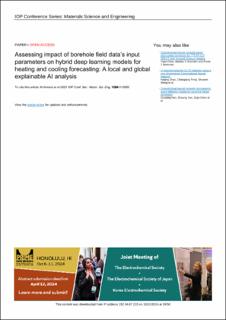| dc.contributor.author | Ahmed, Naveed | |
| dc.contributor.author | Assadi, Mohsen | |
| dc.contributor.author | Zhang, Qian | |
| dc.contributor.author | Awadelseed, Abdelazim Abbas Ahmed | |
| dc.date.accessioned | 2024-04-17T11:59:35Z | |
| dc.date.available | 2024-04-17T11:59:35Z | |
| dc.date.created | 2024-01-03T08:40:43Z | |
| dc.date.issued | 2023 | |
| dc.identifier.citation | Ahmed, N., Assadi, M., Zhang, Q., & Ahmed, A. A. (2023, December). Assessing impact of borehole field data’s input parameters on hybrid deep learning models for heating and cooling forecasting: A local and global explainable AI analysis. In IOP Conference Series: Materials Science and Engineering (Vol. 1294, No. 1, p. 012056). IOP Publishing. | en_US |
| dc.identifier.issn | 1757-8981 | |
| dc.identifier.uri | https://hdl.handle.net/11250/3127035 | |
| dc.description.abstract | Achieving accurate performance forecasting of borehole heat exchanger is essential for optimizing ground source heat pump systems, enabling optimal control, and facilitating energy-efficient operations with enhanced sustainability of the built environment. This study aims to investigate and quantify the impact of model architecture, the number of input data sensors, and their accurate identification on multivariate hybrid deep learning models. Moreover, the significance of incorporating a recent development in deep learning to pay selective attention to the input data i.e., attention-based mechanisms in LSTM-CNN and CNN-LSTM architectures is also investigated. The significance of input parameters for the data-driven AI models is assessed through a significance interpretability analysis utilizing Explainable-AI local-method, namely Shapley Additive Explanations and global-explanation methods i.e., permutation feature importance method and Friedman statistical test. The findings highlight the efficacy of attention mechanisms in capturing temporal dependencies in LSTM-CNN-At and spatial patterns in CNN-LSTM-At, may not necessarily enhance their multistep forecasting capabilities for the borehole field data in comparison to LSTM-CNN architecture. The 24 hours ahead forecasting results show that the order of accuracy is LSTM-CNN> LSTM-CNN-At> CNN-LSTM> CNN-LSTM-At. The findings emphasize that by carefully designing the model layers, it is feasible to remove redundant borehole field sensors for data measurement while maintaining the forecasting accuracy of the hybrid data-driven models. | en_US |
| dc.language.iso | eng | en_US |
| dc.publisher | IOP Publishing | en_US |
| dc.rights | Navngivelse 4.0 Internasjonal | * |
| dc.rights.uri | http://creativecommons.org/licenses/by/4.0/deed.no | * |
| dc.title | Assessing Impact of Borehole Field Data’s Input Parameters on Hybrid Deep Learning Models for Heating and Cooling Forecasting: A Local and Global Explainable AI Analysis | en_US |
| dc.type | Peer reviewed | en_US |
| dc.type | Journal article | en_US |
| dc.description.version | publishedVersion | en_US |
| dc.rights.holder | The authors | en_US |
| dc.subject.nsi | VDP::Teknologi: 500 | en_US |
| dc.source.journal | IOP Conference Series: Materials Science and Engineering | en_US |
| dc.identifier.doi | 10.1088/1757-899X/1294/1/012056 | |
| dc.identifier.cristin | 2219505 | |
| cristin.ispublished | true | |
| cristin.fulltext | original | |
| cristin.qualitycode | 1 | |

